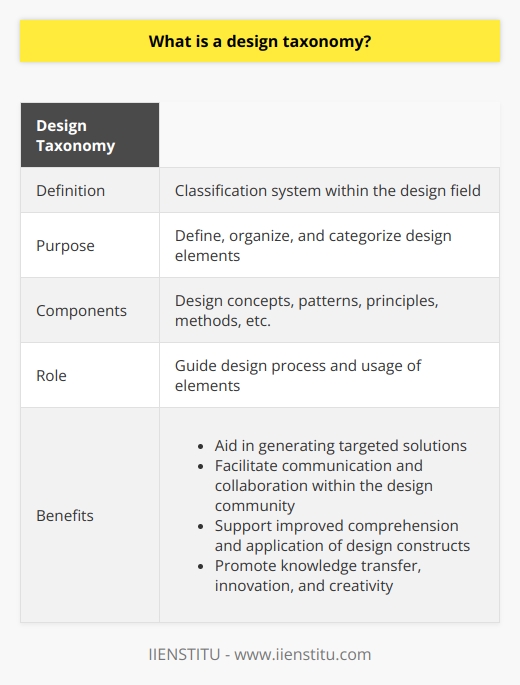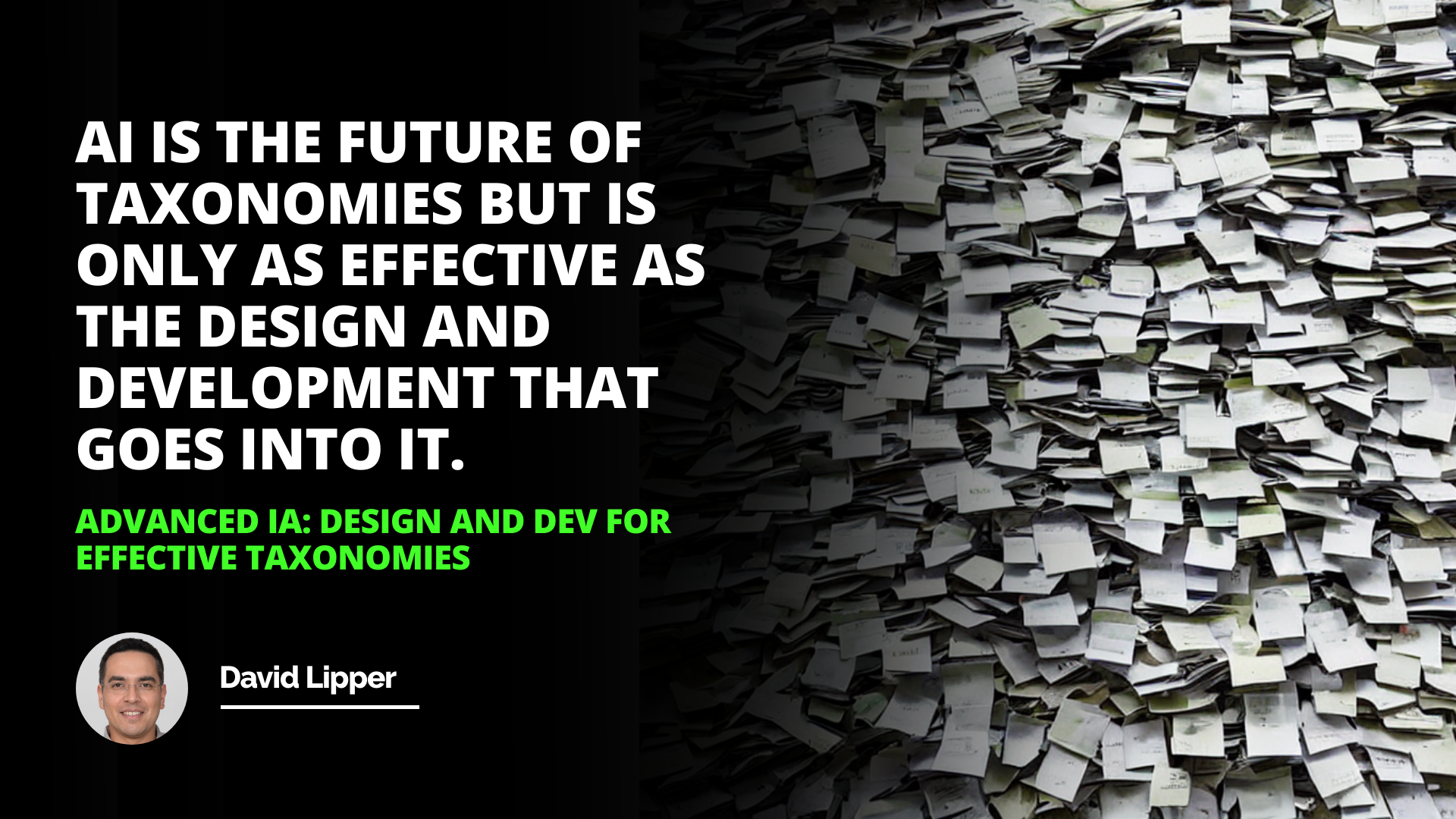
As someone who has spent years working in the field of information architecture (IA), I can personally attest to the crucial role that taxonomies play in organizing and presenting content effectively. When I first started my career as an IA consultant, I was tasked with helping a large e-commerce company restructure their website's navigation and product categorization. It was a daunting project, but I quickly realized that the key to success lay in developing a well-designed taxonomy.
I remember sitting down with the company's stakeholders and subject matter experts, trying to understand the intricacies of their product catalog and the way their customers interacted with the website. We spent countless hours discussing and debating the best way to classify and organize the products, taking into account factors like user behavior, search patterns, and business goals.
One of the biggest challenges we faced was striking the right balance between granularity and simplicity. We wanted to create a taxonomy that was detailed enough to provide meaningful context and aid discoverability, but not so complex that it overwhelmed users or made navigation difficult. It was a delicate balancing act, but through iterative design and testing, we eventually arrived at a taxonomy that met both user needs and business objectives.
Looking back on that project, I can see how it laid the foundation for my understanding of taxonomy design best practices. Over the years, I've worked on numerous IA projects across various industries, and I've come to appreciate the importance of taxonomies in information architecture. Whether it's an e-commerce site, a corporate intranet, or a knowledge management system, a well-designed taxonomy is essential for helping users find what they need quickly and easily.
So, what exactly is a taxonomy, and why does it matter so much in IA? At its core, a taxonomy is a structured way of organizing information based on predefined categories and relationships. It's essentially a blueprint for how content should be classified, labeled, and connected within a given system.
The benefits of using taxonomies for content organization are numerous:
1- Improved findability: By grouping related content together and providing clear labels and hierarchy, taxonomies make it easier for users to locate the information they need.
2- Enhanced navigation: A well-designed taxonomy provides a logical and intuitive structure for users to browse and explore content, reducing cognitive load and improving the overall user experience.
3- Better search results: Taxonomies can inform search algorithms, helping to surface more relevant and accurate results based on the relationships between content items.
4- Increased consistency: By establishing a controlled vocabulary and standardized way of classifying content, taxonomies promote consistency across the system, reducing ambiguity and confusion.
5- Scalability: As content grows and evolves over time, a robust taxonomy provides a framework for accommodating new information and ensuring that it is properly integrated into the existing structure.
Of course, creating a successful taxonomy is no easy feat. It requires a deep understanding of the content domain, user needs, and business goals. Taxonomy design best practices include:
1- Conducting thorough user research to identify common tasks, pain points, and mental models.
2- Collaborating with subject matter experts to ensure that the taxonomy accurately reflects the content's inherent structure and relationships.
AI is the future of taxonomies but is only as effective as the design and development that goes into it.
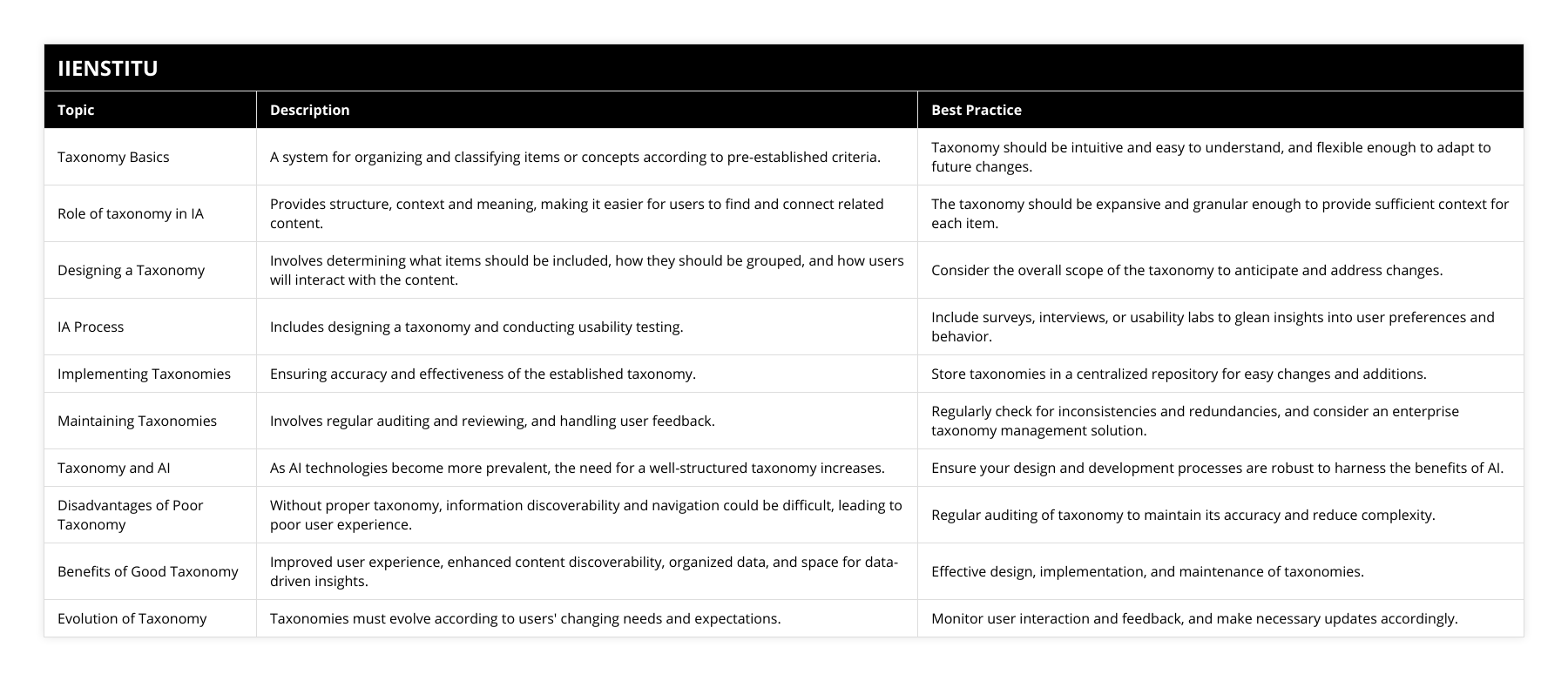
3- Using clear, concise labels that are easily understandable by users.
4- Ensuring that the taxonomy is flexible enough to accommodate future growth and changes.
5- Testing and iterating on the design based on user feedback and usage data.
In recent years, the role of AI in taxonomy development has become increasingly important. Machine learning algorithms can help automate the process of classifying and tagging content, reducing manual effort and improving consistency. However, it's important to remember that AI is only as good as the training data and rules that it's based on. Human expertise and judgment are still essential for creating effective taxonomies that meet user needs.
One of the most memorable projects I worked on involved helping a large financial institution develop a taxonomy for their internal knowledge management system. The challenge was that the organization had a vast amount of content spread across multiple repositories, with little consistency in how it was organized or labeled.
We started by conducting a content audit to get a sense of the scope and nature of the information we were dealing with. We then held workshops with key stakeholders from different departments to understand their specific needs and pain points when it came to finding and using content.
Based on this research, we developed a draft taxonomy that organized content into high-level categories like "Products," "Services," "Regulations," and "Policies." Within each category, we created more granular subcategories and facets to help users drill down and find specific pieces of information.
One of the key decisions we made was to use a combination of taxonomy structure examples that had proven effective in similar contexts. For example, we drew inspiration from the way that legal documents are typically organized, with clear distinctions between laws, regulations, and policies. We also looked at how other financial institutions had structured their content taxonomies, taking note of what worked well and what could be improved.
Throughout the design process, we made sure to keep the end-users front and center. We conducted usability testing with a representative sample of employees to gauge their reaction to the proposed taxonomy and identify any areas of confusion or frustration. Based on their feedback, we made several iterations to the design, refining the labels and hierarchy until we arrived at a structure that was intuitive and easy to navigate.
Once the taxonomy was finalized, we worked closely with the client's IT team to implement the taxonomy in their IA system. This involved mapping the taxonomy to the existing content repositories, developing a metadata schema, and creating a governance plan to ensure that the taxonomy would be maintained and updated over time.
The end result was a knowledge management system that was far more effective and efficient than what the organization had previously. Employees reported that they were able to find the information they needed much more quickly and easily, which translated into significant time savings and productivity gains.
Looking back on this project, I can see how it exemplifies many of the key steps to create a successful taxonomy:
1- Start with a clear understanding of user needs and business goals.
2- Conduct thorough research and analysis to identify patterns and relationships within the content.
3- Use proven taxonomy structure examples as a starting point, but adapt them to the specific context and requirements.
4- Collaborate with stakeholders and subject matter experts to ensure that the taxonomy accurately reflects the content domain.
5- Test and iterate on the design based on user feedback and usage data.
6- Develop a clear plan for how to implement the taxonomy in IA systems and processes.
7- Establish governance mechanisms to ensure that the taxonomy remains up-to-date and relevant over time.
Of course, creating a successful taxonomy is just one piece of the puzzle when it comes to optimizing the user experience. Taxonomy and user experience optimization go hand-in-hand, and there are many other factors to consider, such as interface design, search functionality, and content strategy.
One example of how taxonomies can impact the user experience is in the realm of e-commerce. A study by Baymard Institute found that "more than 60% of e-commerce sites require users to guess or infer category scopes, as the sites do not clearly communicate which items are included or excluded from each category." (Baymard Institute, 2020) This lack of clarity can lead to frustration and confusion for users, resulting in abandoned searches and lost sales.
On the other hand, a well-designed taxonomy can greatly enhance the user experience by providing clear and intuitive paths to the products or information that users are looking for. A study by the Nielsen Norman Group found that "websites with a clear, logical, and visible taxonomy are more successful than those without." (Nielsen Norman Group, 2014) By organizing content in a way that aligns with users' mental models and expectations, taxonomies can reduce cognitive load and make it easier for users to find what they need.
Another area where taxonomies can have a significant impact is in the realm of enterprise search. In large organizations with vast amounts of content and data, finding the right information can be a daunting task. A study by the International Data Corporation (IDC) found that "knowledge workers spend an average of 2.5 hours per day, or roughly 30% of their workday, searching for information." (International Data Corporation, 2009)
A well-designed taxonomy can help mitigate this problem by providing a structured way to organize and access information. By using a consistent and standardized vocabulary, taxonomies can improve search precision and recall, making it easier for users to find the information they need quickly and efficiently. This can translate into significant time savings and productivity gains for organizations.
Of course, creating an effective taxonomy is not a one-time event, but rather an ongoing process that requires regular maintenance and updates. As new content is created and user needs evolve, it's important to continually assess and adapt the taxonomy to ensure that it remains relevant and effective.
This is where the best tools for managing taxonomies can be incredibly valuable. There are a range of software solutions available that can help organizations create, manage, and maintain their taxonomies over time. These tools often include features like automated tagging, machine learning algorithms, and user feedback mechanisms to help ensure that the taxonomy remains up-to-date and aligned with user needs.
One of the key benefits of using these tools is that they can help streamline the taxonomy management process and reduce the burden on manual labor. By automating certain tasks and providing a centralized platform for collaboration and governance, these tools can help organizations save time and resources while ensuring that their taxonomies remain effective and relevant.
Another important aspect of taxonomy management is ensuring that it aligns with broader organizational goals and strategies. A study by the Association for Information and Image Management (AIIM) found that "organizations with a clear and documented information governance strategy are more likely to have a successful taxonomy than those without." (Association for Information and Image Management, 2018)
This highlights the importance of taking a holistic approach to taxonomy design and management, one that considers not just the immediate needs of users, but also the broader context of the organization's information ecosystem. By aligning the taxonomy with information governance policies and procedures, organizations can ensure that it supports broader business objectives and helps drive strategic decision-making.
Ultimately, the power of taxonomies lies in their ability to bring order and structure to the chaos of information. By providing a clear and consistent way to organize and access content, taxonomies can help organizations unlock the full value of their information assets and empower users to find what they need quickly and easily.
As the volume and complexity of information continues to grow, the need for effective taxonomies will only become more pressing. By investing in the right tools, processes, and strategies for taxonomy design and management, organizations can position themselves for success in the digital age and beyond.
References:
Morville, P., & Rosenfeld, L. (2006). Information Architecture for the World Wide Web, 3rd Edition. O'Reilly Media.
AIIM. (2018). "Taxonomy & Metadata: Key Elements of Information Governance." Association for Information and Image Management.
Baymard Institute. (2020). "E-Commerce Search Usability: Best-in-Class Examples, UX Guidelines, & Benchmarking Scores." Baymard Institute E-Commerce Search Usability Report.
IDC. (2009). "The High Cost of Not Finding Information." International Data Corporation.
Nielsen Norman Group. (2014). "Usability of Websites for Children: Design Guidelines for Targeting Users Aged 3–12 Years." Nielsen Norman Group.
Frequently Asked Questions
What are the best practices for designing and developing an effective taxonomy?
Designing and developing an adequate taxonomy is a core skill for information architects and many digital professionals. A good taxonomy enables abstract concepts and ideas to be structured, organized, and navigated, allowing users to easily search, find, and understand their desired information. It also defines relationships between objects and provides a way to classify connected things. This article will give an overview of best practices for designing, developing, and maintaining an adequate taxonomy.
The first step of designing an adequate taxonomy is understanding the specific problem or application for which the taxonomy is being created. Information architects must conduct an initial needs assessment and understand the project's scope to do this. Additionally, it is essential to define the size of the taxonomy—what types of content and objects should be included and how they should be organized.
One of the critical components of a successful taxonomy is understanding the context of the content being organized. For example, information architects should aim to structure concepts regarding user experience—what is the most intuitive and meaningful way to group objects? Additionally, content must be organized to reflect the logical relationships between ideas, with the most specific and commonly-used concepts lower in the hierarchy.
Information architects must consider how content can be searched, cross-referenced, and browsed to ensure their taxonomies are effective. Taxonomies should be designed to be easy to use and to facilitate the retrieval of relevant content. Additionally, the taxonomy should be dynamically expandable to add or modify objects and concepts quickly.
Finally, it is essential to maintain and optimize the taxonomy regularly. This includes reviewing and refining the structure of the taxonomy, checking for errors and inconsistencies, and ensuring that the taxonomy is up to date with new content. Additionally, collecting feedback from users can help to improve the taxonomy further.
In summary, designing and developing an adequate taxonomy requires understanding the project's scope and the context of the content being organized. In addition, information architects should aim to define concepts in terms of user experience, tend to the relationships between ideas, ensure that the taxonomy is easy to use and dynamically expandable, and maintain and optimize it regularly. By following these best practices, information architects can create effective taxonomies that give users quick and easy access to the information they need.
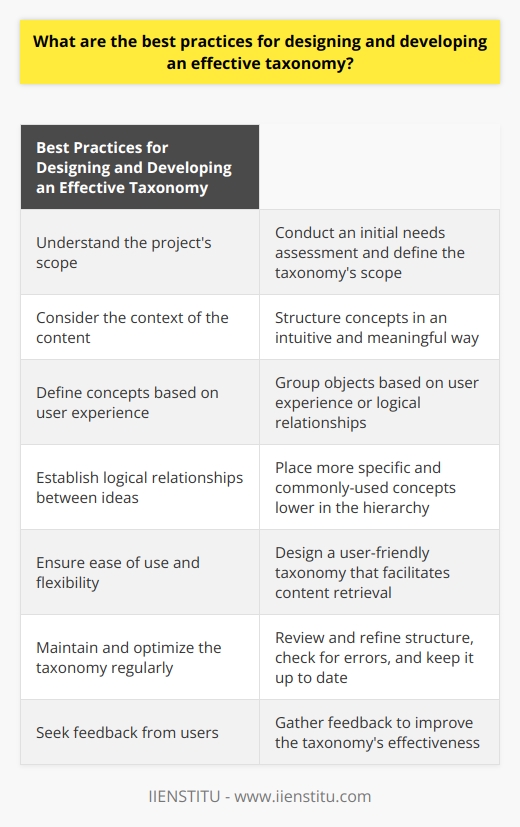
What is the best way to define and maintain a successful taxonomy?
Creating and maintaining a successful taxonomy is a critical component to the success of any business, regardless of size or industry. In addition, taxonomies play an essential role in information management, navigation, and organization. As such, companies must ensure their taxonomies are appropriately defined and maintained to maximize efficiency and accuracy in all business operations.
The first step to defining a successful taxonomy is to define a taxonomy hierarchy. This involves determining the logical taxonomy structure, limiting the scope of the taxonomy, and defining contextual terms for each node. Additionally, it is essential to consider user requirements, the architecture of the taxonomy scheme, and the use of synonyms. Finally, to ensure the accuracy and success of the taxonomy, it is also important to include data validation processes and procedures.
The next step in creating a successful taxonomy is to set up rules for creating and maintaining the taxonomy. It is essential to consider the characteristics of the data, any labor-intensive processes, and the technical processes of maintaining the taxonomy. Additionally, it is necessary to define the roles and responsibilities of team members and ensure they are trained appropriately.
Once the taxonomy is established and maintained, reviewing and updating its terms and categories is essential. As businesses and their respective data evolve, it is necessarupdatings to reflect the data accurately. Additionally is necessary, it may be required to add new terms or modify existing terms.
Overall, defining and maintaining a successful taxonomy is a critical component in achieving success with any business. By appropriately defining the taxonomy hierarchy, setting up rules for creation and maintenance, and regularly updating the taxonomy, companies can ensure accuracy and efficiency in their operations.
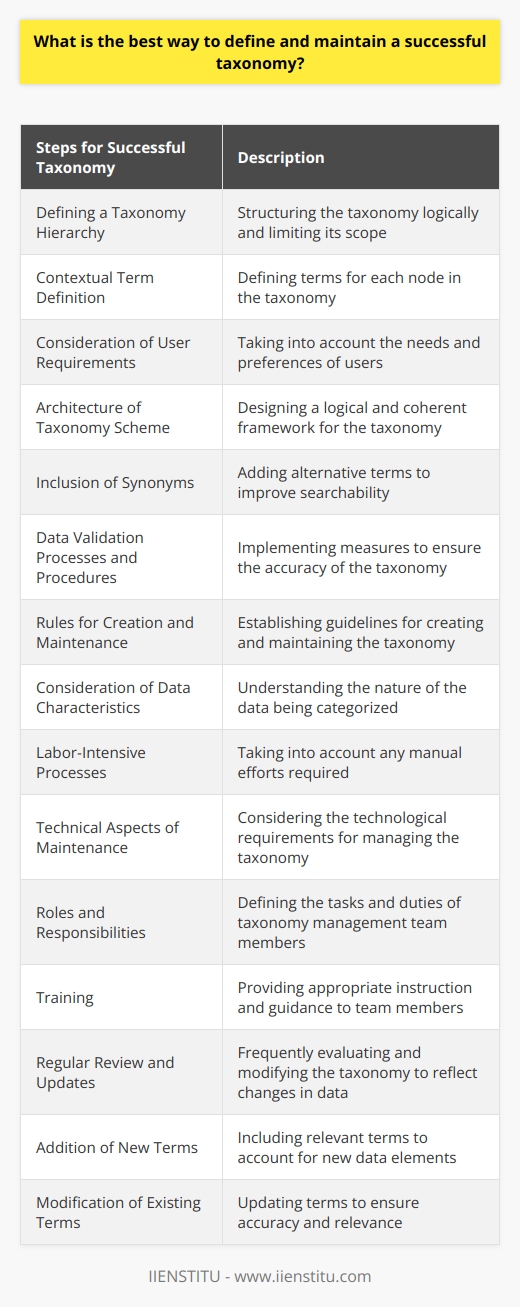
How can I ensure consistent usage of tone of voice in my taxonomy?
Consistent usage of tone of voice within the framework of taxonomy is essential for the successful organization and presentation of web content. Over time, maintaining a consistent tone of voice across different content creation teams can help create a unified and cohesive user experience. This article discusses the most effective tactics for ensuring a consistent tone of voice in a taxonomy.
First, it is essential to clearly define each of the tones of voice components necessary for a successful taxonomic system. Next, the language and stylistic elements contributing to the voice style should be understood. This includes vocabulary choice, language register, sentence structure, and length, among other factors. Once these elements are identified, they should be documented and shared among team members.
Second, establishing official style and tone of voice guidelines is critical to ensure that the tone of voice across the taxonomy remains consistent. These guidelines should be kept up-to-date, comprehensive, and widely accessible to ensure they guide any new content. Additionally, writers should be thoroughly briefed on the tone of voice before creating content.
Third, content-management systems should also be set up to help ensure the consistent application of tone of voice. Automation through technology can be used to automate the process of formatting content. This can include auto-corrections for spelling and grammatical errors and automated stylistic changes that adhere to established guidelines.
Finally, the taxonomy design should be considered to promote a consistent application of tone of voice. The design should consider the organization of topics as well as the hierarchy of the taxonomy. This will ensure that similar content is organized and all writers follow the same style and tone.
In conclusion, having a consistent tone of voice in taxonomy is essential for a practical user experience. Establishing and documenting language and stylistic elements, establishing official style and fashion of voice guidelines, utilizing content management systems, and designing the taxonomy are effective tactics for upholding a consistent tone of voice in the taxonomy. By following these practices, professionals can be assured that the tone of voice in their taxonomy is adequately maintained and presented.
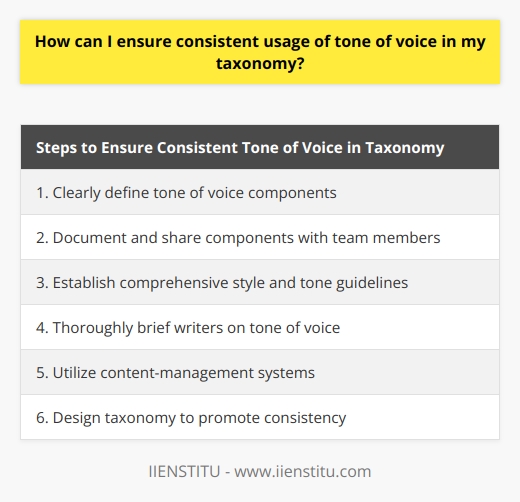
How do you create an effective taxonomy?
Creating an Effective Taxonomy
Identify Primary Categories
Creation of an effective taxonomy starts with identification of primary categories. This demands an understanding of user behavior and content. A comprehensive audit of existing content helps ensure its categorization matches user search needs.
Define Subcategories
Following primary category designations, you should define subcategories. These lower-level categories provide further structure, enhancing the user experience.
Establish Hierarchical Relationships
Presenting a clear hierarchical relationship among categories is crucial. This ensures that users easily traverse through different levels of content. A clear hierarchy also allows broad overviews of content at primary levels and specific details at lower levels.
Consider Breadth and Depth
Balance is key when establishing the breadth and depth of a taxonomy. Although detailed categories offer a comprehensive approach, an overwhelming number of categories might confuse users. Conversely, broad categories may not provide sufficient information.
Stress Test the Taxonomy
Once you have established your taxonomy, you should extensively test it. This includes both usability testing with users and peer reviews by experts in the field. These tests ensure that the taxonomy is efficient and effective.
Revise Regularly
Taxonomies should not remain static. Regular revisions which align the taxonomy with changes in user behavior and the content it encompasses ensure its continued relevancy.
In conclusion, by thoughtfully identifying primary categories, defining subcategories, establishing a clear hierarchy, balancing breadth and depth, conducting stress testing, and facilitating regular revisions, an effective blog post taxonomy can be created. This process, when done correctly, significantly improves user experience and content management.
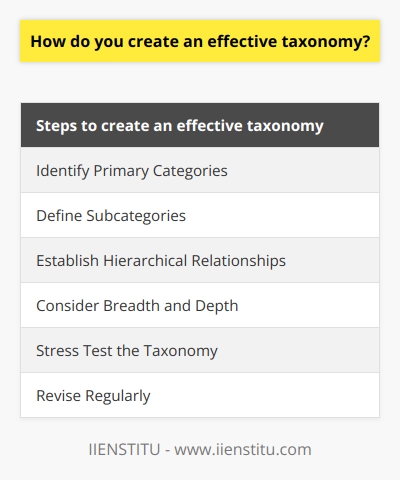
What is the difference between IA and taxonomy?
Understanding IA and Taxonomy
It is crucial to differentiate Information Architecture (IA) and taxonomy in the sphere of information organization. IA involves the creation of a structured design of information environments to aid usability and findability. It centers on organizing, structifying, and labeling information effectively and coherently. In the digital context, it facilitates easy navigation on websites, databases, apps, or other platforms.
Defining Taxonomy
On the other hand, taxonomy serves as a component of IA. It refers to a classification system that helps in organizing and labeling information into hierarchical, relational, or associative structures. Using taxonomy, we can classify information or content into various categories and subcategories—leading to improved findability and seamless navigation.
IA and Taxonomy: Key Differences
While the two are closely interrelated and often used together in information design, the main differences lie in scope and function. IA represents a broader concept, encompassing the entire system of information structure and design, which includes but not exclusive to, system layout, interface design, and navigation design.
Taxonomy, conversely, is a specific component within IA that focuses solely on the classification of information. Furthermore, IA is more concerned with enhancing user experience through effective information layout and design, while taxonomy ensures that users can efficiently find and retrieve information through logical categorization.
In summary, even though IA and taxonomy are different in their scope of operation and functional emphasis, they are interdependent and both vital to effective information design and management. They work complementarily to create an information-rich, user-friendly, and easily navigable digital interface.
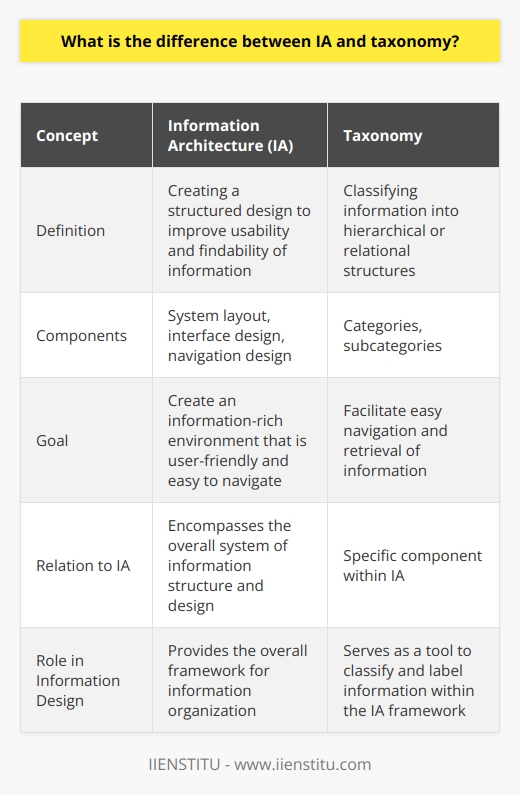
What is a design taxonomy?
Understanding Design Taxonomy
A design taxonomy essentially denotes a system of classification within the field of design. This terminology pertains to defining, organizing and categorizing various design aspects according to their similarities and differences.
Explanation of Design Taxonomy
Design taxonomy takes into account multiple factors. These include design concepts, patterns, principles, methods, etc. The purpose is to offer a structured approach in understanding and utilizing these elements effectively.
Role of Design Taxonomy
In design practice, this taxonomy guides the process and usage of design elements. It aids in generating targeted solutions that are both efficient and effective. It also facilitates communication within the design community, thereby increasing collaboration and improving outcomes.
Importance and Benefits
The importance of design taxonomy lies in its ability to support improved comprehension and application of design constructs. It enables designers to easily retrieve relevant information and apply the same in their work. Additionally, it promotes the transfer of knowledge within the design field, thereby fostering innovation and creativity.
In conclusion, design taxonomy is instrumental in shaping the scope and direction of design practices. It provides a structured method for understanding, interpreting, and applying design elements effectively. Owing to its strategic importance in the field, it proves beneficial for both practitioners and learners alike.
